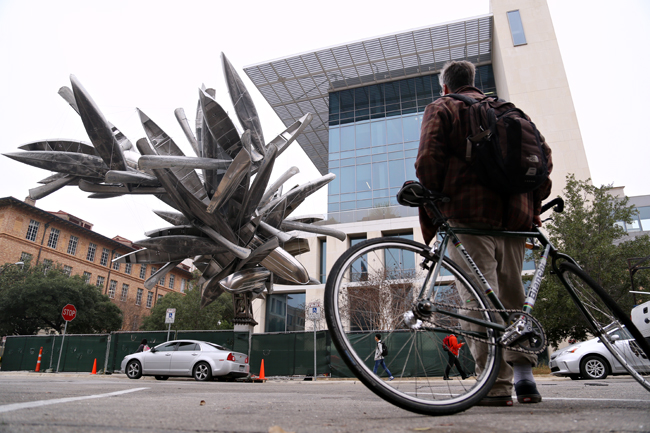The inspiration for “Monochrome for Austin” — the canoe-based sculpture that’s generated significant buzz on campus since its installation earlier this year — came from the designer Nancy Rubins’ previous work with war airplane parts, she said at a celebration of the sculpture Thursday.
“My husband had a rowing canoe, and I was looking at it, and I’d say, ‘God, it’s amazing, this canoe — It really reminds me of the airplane parts,’” Rubins said. “It made perfect sense — after the war, the company that had made war planes started making canoes. And I started thinking about that, God, those things are beautiful.”
Nancy Rubins, the artist who designed the “Monochrome for Austin” sculpture participates in a Q&A held in the Norman Hackerman Building on Thursday evening. The sculpture, which stands at 50 feet tall, was finished in mid-January at a cost of $1.4 million. Mariana Muñoz | Daily Texan Staff
“Monochrome for Austin” is a 50-foot tall sculpture made of stainless steel and aluminum canoes located at the corner of Speedway and 24th Street near the Norman Hackerman Building. Landmarks, UT’s public art program, finished the installation of the sculpture in mid-January at a cost of $1.4 million. The sculpture is part of a series of similarly designed canoe sculptures found in the U.S. and other countries.
Margo Sawyer, sculpture and extended media art professor, said she welcomed the discussion “Monochrome” brought to the campus. The sculpture has received mixed reviews from students.
“I didn’t realize until tonight, that the canoes are made by the same people who made the war planes,” Sawyer said. “I think it’s a really amazing work and it’s been very controversial, and I think that controversiality is a really good thing. It gets people talking and thinking and questioning.”
Rubins said she relied on engineers to make sure the sculpture was structurally safe.
“A lot of the stuff I built for many years, I built without engineers because I knew through just gradual experience that if I did this, and this, and this, it would work, you know?” Rubins said. “But once you get in the public realm, you have to be really responsible and careful that way — and then you bring in the engineer to make sure that you’re still this good, that the welds are good, that the design is good.”
Racheal Lute, a civil engineering graduate student, said she found Monochrome’s improvisational design process surprising.
“I found it really interesting to learn that the location of each canoe was not predetermined,” Lute said. “I am an engineer, so, to me, all designs are finalized before you go into construction. It was kind of interesting to know that it was a more improvisational technique. … The first time I saw the art, I was like, ‘Oh my God, that could fall on somebody,’ but I’m glad that she used a structural engineer.”





















